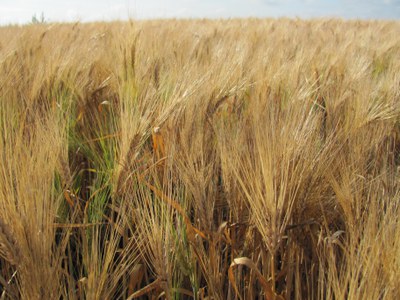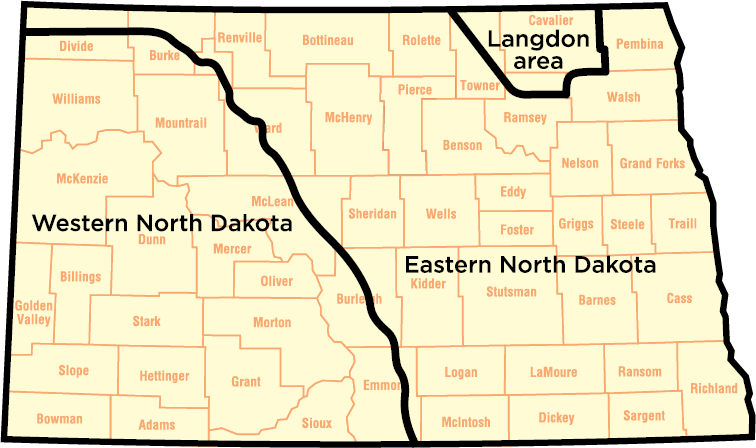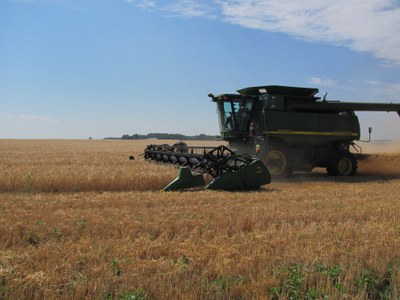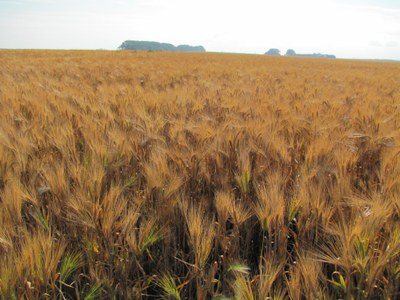The total N requirements for six-row barley production are indicated in Tables 1-2. Total N requirements are the sum of residual nitrate-N soil analysis to 2 feet in depth, previous crop credits (Table 7), and an adjustment for six years or more continuous no-till/one-pass seeding.
Table 1. Barley, feed grade in North Dakota in conventional tillage systems.
|
Total available N*, pounds per acre
|
Soil Test P, ppm
|
Soil Test K, ppm
|
|
VL
|
L
|
M
|
H
|
VH
|
VL
|
L
|
M
|
H
|
VH
|
|
0-3
|
4-7
|
8-11
|
12-15
|
16+
|
0-40
|
41-80
|
81-120
|
121-150
|
151+
|
|
Pounds P2O5 per acre
|
Pounds K2O per acre
|
|
*Total available N includes residual soil nitrate-N to a 2-foot depth, previous crop N credit, and supplemental N from fertilizers, manures or other sources. In the Langdon region, subtract 30 pounds N/acre from N recommendation.
|
|
150
|
78
|
60
|
52
|
26
|
0
|
90
|
60
|
45
|
30
|
0
|
Table 2. Barley, feed grade in North Dakota in no-till systems.
|
Total available N*, pounds per acre
|
Soil Test P, ppm
|
Soil Test K, ppm
|
|
VL
|
L
|
M
|
H
|
VH
|
VL
|
L
|
M
|
H
|
VH
|
|
0-3
|
4-7
|
8-11
|
12-15
|
16+
|
0-40
|
41-80
|
81-120
|
121-150
|
151+
|
|
Pounds P2O5 per acre
|
Pounds K2O per acre
|
|
*Total available N includes residual soil nitrate-N to a 2-foot depth, previous crop N credit, and supplemental N from fertilizers, manures or other sources. In the Langdon region, subtract 30 pounds N/acre from N recommendation.
|
|
120
|
78
|
60
|
52
|
26
|
0
|
90
|
60
|
45
|
30
|
0
|
Soil sampling is usually conducted the fall before planting, although early spring sampling can also be conducted. Neither time is superior to the other in terms of nitrate-N values it will generate. Site-specific zone soil sampling may help to reduce over- or under-fertilization in areas of the field compared to a composite soil sampling approach.
The adjustment for long-term no-till production is due to an apparent decrease in N rate required for maximum yields in spring wheat, corn and sunflower research conducted at NDSU over the past 10 years. In fields that are transitioning to no-till, or are no-till during only part of the rotation, an additional 20 pounds N per acre would be required to overcome the tie-up of N by residue before soil microbial communities convert to a more efficient N cycling system. In the Langdon region, subtract an additional 30 pounds N per acre from the six-row barley N recommendation.
The N rates for yield and to achieve malting grade protein of less than 14%, the N rates are more conservative than for barley grown for feed. For six-row barley, the crop needs to be slightly N deficient in order to achieve malting grade protein. For two-row barley, N rates can be slightly greater. In drought years, the chances of making malting grade protein are low, as any beginning residual nitrate along with the most conservative N rates will result in higher protein barley.
The alternative to recommended N rates applied at planting in a year with limited spring subsoil moisture is to split the N required, with perhaps half the N rate applied by seeding, and then guessing on what rainfall might be received the next six weeks and applying either the other half of the recommended N, and less N or no additional N should the outlook be bleak for rainfall the next 30 days.
No additional N should be applied after five-leaf barley, as a great share of the application will produce more protein than grain. The economic optimal N rate for two-row barley for the western, eastern and Langdon regions of North Dakota are provided in Tables 3-5. The values need to be adjusted for soil nitrate-N to a depth of 2 feet, long-term no-till (subtract 50 pounds N per acre) and for previous crop N credits (Table 6).
Table 3. Malting 2-row barley, western region, economic N rates with N cost and barley price.
|
$/bu
|
Cost of N, $/pound N
|
|
0.20
|
0.30
|
0.40
|
0.50
|
0.60
|
0.70
|
0.80
|
0.90
|
1.00
|
1.10
|
1.20
|
1.30
|
1.40
|
1.50
|
1.60
|
1.70
|
1.80
|
1.90
|
2.00
|
|
3
|
140
|
130
|
120
|
102
|
103
|
94
|
84
|
74
|
65
|
55
|
46
|
38
|
28
|
19
|
10
|
0
|
0
|
0
|
0
|
|
4
|
144
|
137
|
131
|
124
|
117
|
110
|
102
|
96
|
89
|
82
|
75
|
68
|
61
|
54
|
47
|
40
|
32
|
26
|
19
|
|
5
|
147
|
142
|
136
|
131
|
125
|
120
|
114
|
108
|
102
|
97
|
92
|
86
|
81
|
75
|
69
|
64
|
58
|
53
|
47
|
|
6
|
149
|
144
|
140
|
135
|
131
|
126
|
121
|
117
|
112
|
109
|
103
|
98
|
94
|
89
|
84
|
80
|
75
|
70
|
65
|
|
7
|
150
|
146
|
143
|
138
|
135
|
131
|
127
|
123
|
119
|
115
|
111
|
107
|
103
|
99
|
95
|
91
|
87
|
83
|
79
|
|
8
|
151
|
148
|
144
|
141
|
137
|
135
|
132
|
127
|
124
|
120
|
117
|
113
|
110
|
106
|
103
|
99
|
96
|
92
|
89
|
|
9
|
152
|
149
|
146
|
143
|
140
|
137
|
134
|
131
|
127
|
124
|
121
|
118
|
115
|
112
|
109
|
106
|
103
|
100
|
97
|
|
10
|
153
|
150
|
147
|
144
|
142
|
139
|
136
|
133
|
131
|
128
|
125
|
123
|
119
|
119
|
114
|
111
|
108
|
106
|
103
|
Table 4. Malting 2-row barley, eastern region, economic N rates with N cost and barley price.
|
$/bu
|
Cost of N, $/pound N
|
|
0.20
|
0.30
|
0.40
|
0.50
|
0.60
|
0.70
|
0.80
|
0.90
|
1.00
|
1.10
|
1.20
|
1.30
|
1.40
|
1.50
|
1.60
|
1.70
|
1.80
|
1.90
|
2.00
|
|
3
|
145
|
138
|
131
|
125
|
117
|
110
|
104
|
97
|
89
|
82
|
75
|
68
|
61
|
54
|
46
|
40
|
33
|
26
|
19
|
|
4
|
148
|
144
|
137
|
132
|
127
|
122
|
117
|
111
|
106
|
101
|
96
|
91
|
85
|
80
|
75
|
70
|
65
|
59
|
54
|
|
5
|
150
|
146
|
142
|
137
|
133
|
129
|
125
|
121
|
117
|
112
|
108
|
104
|
100
|
96
|
92
|
87
|
83
|
79
|
75
|
|
6
|
151
|
148
|
144
|
141
|
137
|
134
|
131
|
127
|
124
|
120
|
117
|
113
|
110
|
106
|
103
|
99
|
96
|
92
|
89
|
|
7
|
152
|
149
|
146
|
146
|
140
|
137
|
135
|
132
|
129
|
126
|
123
|
120
|
117
|
114
|
111
|
108
|
105
|
102
|
99
|
|
8
|
153
|
151
|
148
|
148
|
143
|
140
|
137
|
135
|
132
|
130
|
127
|
124
|
122
|
119
|
117
|
114
|
111
|
109
|
106
|
|
9
|
154
|
152
|
149
|
149
|
144
|
142
|
140
|
137
|
135
|
133
|
131
|
128
|
126
|
124
|
121
|
120
|
117
|
114
|
112
|
|
10
|
154
|
152
|
150
|
150
|
146
|
144
|
142
|
140
|
137
|
135
|
133
|
131
|
131
|
127
|
125
|
123
|
121
|
119
|
117
|
Table 5. Malting 2-row barley, Langdon area, economic N rates with N cost and barley price.
|
$/bu
|
Cost of N, $/pound N
|
|
0.20
|
0.30
|
0.40
|
0.50
|
0.60
|
0.70
|
0.80
|
0.90
|
1.00
|
1.10
|
1.20
|
1.30
|
1.40
|
1.50
|
1.60
|
1.70
|
1.80
|
1.90
|
2.00
|
|
3
|
115
|
108
|
101
|
95
|
87
|
80
|
84
|
67
|
59
|
52
|
45
|
38
|
31
|
24
|
46
|
10
|
0
|
0
|
0
|
|
4
|
118
|
114
|
107
|
102
|
97
|
92
|
87
|
81
|
76
|
71
|
66
|
61
|
55
|
50
|
45
|
40
|
35
|
29
|
24
|
|
5
|
120
|
116
|
112
|
107
|
103
|
99
|
95
|
91
|
87
|
82
|
78
|
74
|
70
|
66
|
62
|
57
|
53
|
49
|
45
|
|
6
|
121
|
118
|
114
|
111
|
107
|
104
|
101
|
97
|
94
|
90
|
87
|
83
|
80
|
76
|
73
|
69
|
66
|
62
|
59
|
|
7
|
122
|
119
|
116
|
116
|
110
|
107
|
105
|
102
|
99
|
96
|
93
|
90
|
8/7
|
84
|
81
|
78
|
75
|
72
|
69
|
|
8
|
123
|
121
|
118
|
118
|
113
|
110
|
107
|
105
|
102
|
100
|
97
|
94
|
92
|
89
|
87
|
84
|
81
|
79
|
76
|
|
9
|
124
|
122
|
119
|
119
|
114
|
112
|
110
|
107
|
105
|
103
|
101
|
98
|
96
|
94
|
91
|
90
|
87
|
84
|
82
|
|
10
|
124
|
122
|
120
|
120
|
116
|
114
|
112
|
110
|
107
|
105
|
103
|
101
|
101
|
97
|
95
|
93
|
91
|
89
|
87
|
Table 6. Previous Crop Credits
|
Previous crop
|
Credit
|
|
Soybean
|
40 lb. N/acre
|
|
Dry edible bean
|
40 lb. N/acre
|
|
Other grain legume crops (field pea, lentil, chickpea, faba bean, lupin)
|
40 lb. N/acre
|
|
Harvested sweet clover
|
40 lb. N/acre
|
|
Alfalfa that was harvested and unharvested sweet clover:
|
|
|
>5 plants/sq. ft.
|
150 lb. N/acre
|
|
3-4 plants/sq. ft.
|
100 lb. N/acre
|
|
1-2 plants/sq. ft.
|
50 lb. N/acre
|
|
<1 plant /sq. ft.
|
0 lb. N/acre
|
|
Sugarbeet
|
|
|
Yellow leaves
|
0 lb. N/acre
|
|
Yellow/green leaves
|
30 lb. N/acre
|
|
Dark green leaves
|
80 lb. N/acre
|
Half of the N credit indicated for the first year of sweet clover and alfalfa should be given to the second subsequent crop, but no second-year N credit is recommended following other crops.





